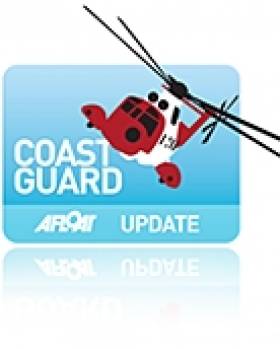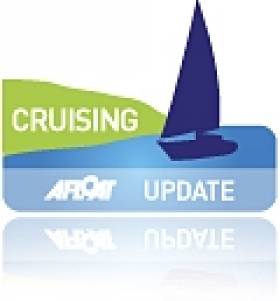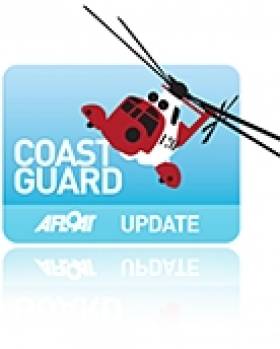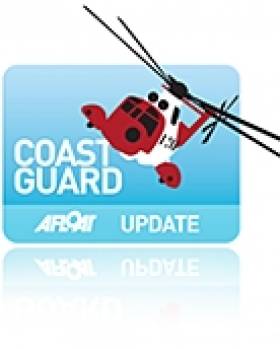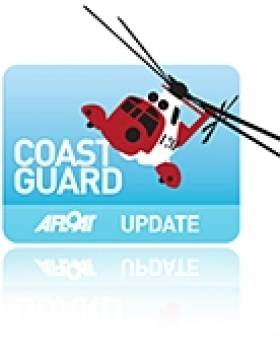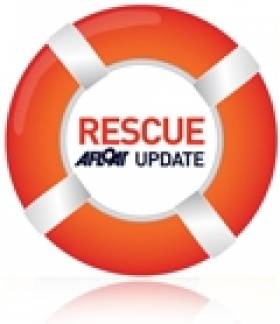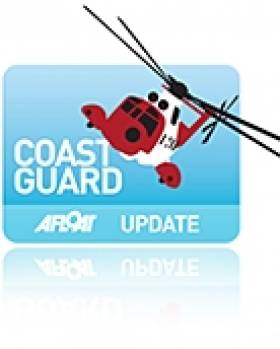Displaying items by tag: Coast Guard
Speaking today, Minister for Transport Leo Varadkar TD said: This invitation to Achill Coast Guard Unit is an acknowledgement of the life-saving work that this Unit (and indeed all our Volunteer Units) around the country are engaged in every day of the year. Every day, these people selflessly risk their own lives to save others in all weathers, day and night, often in very dangerous conditions. This invitation is in recognition of their work and is an indication of the high esteem in which our Coast Guard Units are held internationally."
Achill Island Coast Guard Unit is made up of 24 volunteers who carry pagers and are available on 15 minutes' notice day and night 365 days a year. In August 2009 the Unit took part in a search and rescue operation for a person who fell into the Atlantic Ocean while fishing off the rocks near Achill Island. In response to this incident, the Achill Coast Guard rescue boat was launched together with local RNLI Ballyglass Unit and the Sligo Coast Guard helicopter during very hazardous weather conditions. The casualty (a Mr. Patrick Williamson) who amazingly stayed afloat swimming in high seas for over an hour was successfully rescued and spent 5 days in intensive care following his ordeal in the sea.
On making a full recovery, Mr. Williamson nominated Achill Island Coast Guard Unit for a National Courage Award. Previous recipients of this honour include the Irish Army (for peacekeeping duties) and former Taoiseach Mr. Bertie Ahern (for his involvement in the peace talks in Northern Ireland).
Director of the Irish Coast Guard, Mr. Chris Reynolds today said: "The Achill Coast Guard Unit is well-deserving of this honour and I congratulate them on being part of this special event. It is a great recognition of the standard and quality of service the Coast Guard provide and I thank Mr. Williamson along with all who helped make this happen for inviting them to take part in this special event."
2011 Irish Coast Sailing Directions Published
The Irish Cruising Club's acclaimed Sailing Directions, in two volumes, offer comprehensive coverage of the entire coast of Ireland, and their price has recently been reduced by £10.00 to £27.50 each (€32.50).
These are the only cruising guides for the Irish coast to be frequently and comprehensively updated, with corrections available free at www.irishcruisingclub.com.
The 310 page South and West volume was reviewed in Cruising magazine, Sept 2010: "If you are intending to cruise these coasts, or even if you are only thinking of doing so, it is essential. As Sailing Directions they are well-nigh perfect."
Written, edited, designed and printed on the island of Ireland, these handsome hardback books are carried as an aid to navigation and pilotage by the Irish Naval Service, the Irish Coast Guard and the Commissioners of Irish Lights, and they are used as a reference source by the UK Hydrographic Office.
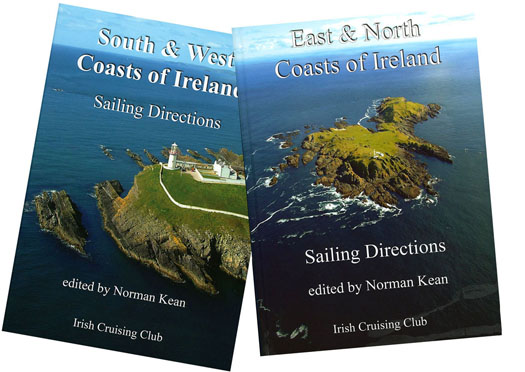
ICC SDs are available from chandlers and booksellers, and are distributed in Great Britain and the rest of the world by Imray, and in Ireland by Todd Chart Services. East and North Coasts Directions ISBN 978 0 9558 199 1 9; South and West Coasts Directions ISBN 978 0 9558 199 2 6.
Labour Manifesto Leads the Way on Irish Maritime Affairs
Fine Gael has told Afloat.ie details of its marine policy will be published in its manifesto tomorrow. If that's the case things are looking up for anyone interested in seeing Ireland develop the valuable waters that surround it.
After searching for references to 'sea', 'marine' or 'maritime' only the Labour party has so far made the only significant written commitment to the marine sector in its programme for government. Its manifesto acknowledges that Coastal Communities, Fisheries and the Marine face major challenges in the years ahead, but it is also an area of major economic potential.
Fianna Fail merely says on page 21 of its manifesto that it will ensure that 'an inter-departmental strategy is in place to improve the leisure potential of our harbours and increase marine tourism'.
The Green Party 'Renewing Ireland' document says it will promote the creation of marinas and youth and child friendly water sports to encourage activity and awareness of our maritime country. It also says Ireland will participates in the North Seas Offshore Grid Plan.
There is no reference to the marine in the Sinn Fein 'There is a Better Way' manifesto.
Four party manifestos are available to download below.
Labour's priority will be to develop Ireland as a European hub for seafood processing, which will create sustainable, value-added jobs in coastal communities.
Labour will also develop an Irish seafood strategy to grow the market profile and demand for Irish seafood products. We will support the development of sustainable aquaculture and fish farms by streamlining the licensing process and reducing, as much as possible, the associated bureaucracy. To further assist the development of the sector, responsibility for maritime policy will, as far as is practicable, be concentrated in one department.
Labour will establish a Sea Fisheries Sustainability Impact Assessment based on consultation with all major stakeholders. This report will be brought before the Dáil on an annual basis before EU fisheries negotiations commence, and will ensure that there is a regular evaluation of Irish fish stocks and the effectiveness of current policy and quotas.
Labour is open to the experience and expertise of those whose livelihoods depend on maritime activity. The Department of Agriculture, Fisheries and Food will engage in an ongoing structured consultation with industry representatives, the marine scientific community and other stakeholders to enable them to contribute to national maritime policy.
Finally, safety at sea and decent working conditions must underpin the development of the fisheries sector. Labour in government will ensure that the Irish Coast Guard has access to an Emergency Towing Vessel.
Dun Laoghaire People before Profit candidate Richard Boyd Barrett who has campaigned under a 'Save our Seafront' banner in the last council elections, is holding a meeting tomorrow night in Dun Laoghaire, the country's largest boating centre to protest against the possible 'privatisation' of the town's harbour.
We're tracking the progress of maritime affairs in the general election and posting details on afloat.ie. Whether you're a candidate or a vote please get in touch with your #ge11 marine news. Contact us via facebook, twitter or our website.
Answers Demanded Over Bangor Closure Proposals
Local people will voice their opposition to the proposed closure of Northern Ireland's only coastguard rescue base at a public meeting with the Maritime and Coastguard Agency (MCA) next month, the Belfast Telegraph reports.
Supporters of the Bangor facility, which provides 24-hour cover for the NI coastline, have also demanded "concrete answers" from UK Shipping Minister Mike Penning, who is due to visit the country next week.
“If he comes here with a positive attitude and says the decision to target our Coastguard was wrong, that’s the outcome we’re hoping for," said Strangford MP Jim Shannon. “If not, then he’s got a fight on his hands. We will take this to Westminster if necessary."
MCA representatibes will meet Bangor MLAs and community leaders on 3 March at the Marine Court Hotel to discuss the proposals.
The Belfast Telegraph has more on the story HERE.
Search and Rescue Services Firm Reports Loss
The Canadian company that provides search and rescue helicopter services for the Coast Guard has reported a €1.5 million operating loss in the 2009-2010 fiscal year, according to the Irish Independent.
CHC Ireland, the local division of the world's largest helicopter services company, operates search and rescue services out of Dublin, Shannon, Waterford and Sligo.
Directors of the firm, which employs more than 100 nationwide, noted that the loss - coming after a €3.2 million loss in the previous financial year - was reduced due to the closure of its Cork base and lower aircraft leasing costs.
Last year the Government awarded CHC a new 10-year contract worth €500 million to operate search and rescue services, despite proposals from the Air Corps that it could provide the same service at a much lower rate.
The Irish Independent reported recently that one of the world's top helicopter makers has denied claims made by the Coast Guard that the Air Corps does not have the equipment to undertake search and rescue operations.
AgustaWestland, which supplies the main helicopter used by the Air Corps, disputed allegations by Coast Guard director Chris Reynolds that the AW139 had not earned a "good reputation" elsewhere.
Coast Guard Appeals Over Chinese Lanterns
The Coast Guard has appealed the public to notify them before lighting and releasing Chinese lanterns.
The lanterns have been a regular sight in the night sky since the beginning of the year, but can resemble emergency flares when they drift out to sea.
Marine rescue services maintain that they have been responsible for an increasing number of false callouts. At least six RNLI boats around the country have been launched as a result of mistakenly identified Chinese lanterns.
Lives could be lost if rescue services are distracted by such false alarms, urged Mike Swan, operations manager of RNLI Galway Lifeboat.
RTÉ News has more on the story HERE.
1,499 Lives Lost in Ten Year Tragic Tide of Drownings
Irish Water Safety is calling for people to be more aware of the dangers presented by water based activities and wants the general public to know that there are many reasons people drown which are not simply limited to warmer weather risk taking. People have a responsibility to themselves and family to stay safe around water by knowing the dangers and learning from the lessons offered by the 1,499 person's lives tragically lost in a ten year period.
A synopsis of some general contributory factors over the years
1. Poor or inadequate equipment (e.g. boats or lifejackets);
2. Alcohol consumption;
3. Falling unexpectedly into water ;
4. Improper use of boats and equipment;
5. Overestimation of skills;
6. Lack of local knowledge when travelling in Ireland and abroad;
7. Not being able to swim;
8. Easy unauthorised access to waterways;
9. Cold;
10. Current (including rip currents, river currents, and tidal currents);
11. Offshore winds (including flotation devices);
12. Pre-existing diseases (e.g. heart attacks);
13. Underwater entanglement;
14. Bottom surface gradient and stability;
15. Waves (coastal, boat);
16. Water transparency;
17. Impeded visibility (including coastal configuration, structures and overcrowding);
18. Lack of parental supervision (infants and children);
19. Change in weather conditions;
20. Excessive 'horseplay' or over exuberant behavior (including "tombstoning" from cliffs);
21. Swimming outside the depth of the user.
22. Suicide and Homicide
A synopsis of some general preventive and management actions
1. Public education by Irish Water Safety regarding hazards and safe behaviours;
2. Teaching children to stay away from water when unsupervised through the IWS PAWS (Primary Aquatics Water Safety) programme;
3. Continual adult supervision of children;
4. IWS media campaigns that drowning can happen quickly and quietly;
5. Promote in IWS press announcements, the restriction of alcohol provision before or during aquatic activities;
6. Provision by Irish Water Safety of properly trained and equipped lifeguards;
7. Provision of rescue services;
8. Irish Water Safety Risk Assessments that include assessments of local hazard warning notices, access to emergency response and availability of resuscitation skills/facilities and other factors;
9. Development by Irish Water Safety of rescue and resuscitation skills among general public and user groups;
10. Coordination by Irish Water Safety with user group associations concerning hazard awareness and safe behaviours;
11. Wearing of adequate lifejackets and Personal Flotation Devices when boating;
12. Fencing and doors to isolate outdoor pools, slurry pits, rivers on farms and other water features near populations.
The 20% decrease in the number of incidents involving leisure and recreational activities to which the Irish Coast Guard had to respond can be accounted for in no small part by the increase in the general public's awareness of water safety best practices. The change in culture on our aquatic environment is comparable to that which saw a huge increase in the wearing of seatbelts in cars over the last two decades. The huge increase in the number of people taking to water-based activities in the last decade saw the culture shift progressively towards a responsibility among the public to wearing lifejackets when taking to water based activities.
New World Class Coast Guard National Marine Operations Centre Opens
This morning Minister for Transport Noel Dempsey TD opened the new Irish Coast Guard National Marine Operations Centre in the Irish Coast Guard headquarters, Leeson Lane, Dublin 2.
The Irish Coast Guard National Maritime Operations Centre houses Ireland’s Maritime Rescue Coordination Centre tasked with looking after our day-to-day emergency search and rescue response needs. It also plays an important coordinating role in dealing with pollution incidents in our waters, salvage and ship casualty response, requests from ships in difficulty and control and surveillance of passing shipping and maritime infrastructure off our coast.
Speaking today Minister Dempsey said; "The opening of this centre is a very significant milestone in the development of our national maritime infrastructure. Today we are launching a new world class digital technology platform for the Irish Coast Guard. For the first time all Coast Guard sites in Ireland will be connected to a national IT system that will help better coordinate search and rescuer missions. We now have a single 24/7 international contact point on ship and port security, coast guard to coast guard requests, marine assistance services, satellite alerts and crisis response in the maritime domain. It is a vital hub that co-ordinates our response to save lives and to protect our waters."
Welcoming the formal opening today, Director of the Irish Coast Guard Chris Reynolds said: "The opening today of our new centre will considerably improve the Coast Guards ability to deliver more effective co-ordination of the national marine search and rescue (SAR) service. The systems under development here will also assist in gathering information and support risk assessments for decision making in respect of vessels seeking places of refuge and providing a vessel traffic monitoring and information service for our coastal areas. It has the technical capacity to independently run any type of incident anywhere off our coast. "
Minister Dempsey concluded: "The vision and determination shown in the past decade by the Irish Coast Guard in advancing our Search and Rescue services is an important reflection of the hard work and commitment of all parties to this project despite the current difficult financial times. In partnership with the International Maritime Organisation, the European Maritime Safety Agency, Bonn Agreement and the EU Civil Protection Mechanism, this centre reflects Ireland's commitment to the single point of contact concept for our national Search and Rescue, ship casualty and marine pollution response needs."
Today the Minister for Transport Mr Noel Dempsey T.D. announced the 2011 Estimates provision for his Department. The following are the principal features of the 2011 Estimates for marine affairs in his remit.
The 2011 capital provision will be €15 million, compared with €13 million in 2010. The principal item of capital expenditure is the provision of a search and rescue helicopter service (€8 million). Also included is expenditure on the Irish Coast Guard, maritime safety and remedial works at regional harbours.
The 2011 provision will be €39 million unchanged from 2010 for current expenditure. The principal item of expenditure is the provision of a search and rescue helicopter service (€27m current expenditure).
Second Attempt to Airlift Injured Crewman Successful
The Shannon-based Coast Guard Helicopter reached the boat shortly before 2pm and succeeded in taking the fisherman, an Egyptian national, on board.
The man, who had sustained serious injuries after being struck by a steel hawser, was to be taken to Cork University Hospital.
An earlier attempt to airlift him from the vessel when it was 110km south of Kinsale had to be abandoned when the helicopter flew into a snowstorm and its cockpit window iced over.


























